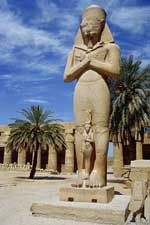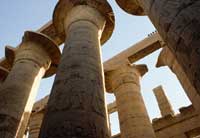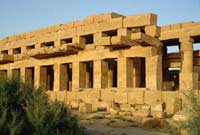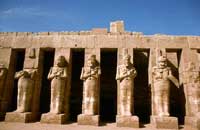|
The Temple of Karnak
 The temple of Karnak used to be connected to the Luxor Temple
via a long stone processional street called a dromos. This road
was built along a canal that once connected the Nile to the
Temple. There was a dock in ancient times, but now all that is
left is the quay and the raised dais. To arrive at the entrance
one follows the dromos with its crio-sphinxes. They have the
head of a Ram and the body of a lion and are symbolic of the God
Amun. Arriving at the temple, there is a statue of Ramesses II
with his son between his feet. The temple of Karnak used to be connected to the Luxor Temple
via a long stone processional street called a dromos. This road
was built along a canal that once connected the Nile to the
Temple. There was a dock in ancient times, but now all that is
left is the quay and the raised dais. To arrive at the entrance
one follows the dromos with its crio-sphinxes. They have the
head of a Ram and the body of a lion and are symbolic of the God
Amun. Arriving at the temple, there is a statue of Ramesses II
with his son between his feet.
The Temple of Karnak is actually three main temples, smaller
enclosed temples, and several outer temples. This vast complex
was built and enlarged over a thirteen hundred years period. The
three main temples of Mut, Monthu and Amun are enclosed by
enormous brick walls. The Open Air Museum is located to the
north of the first courtyard, across from the Sacred Lake and
displays various statues found through out the temple complex.
The main complex, The Temple of Amun, is situated in the center
of the entire complex. The Temple of Monthu is to the north of
the Temple of Amun, while the Temple of Mut is to the south.
The Second Pylon of Karnak was built by Ramesses II. The
Ptolemies did some extensive repairing and some new building on
the center section.
 The Hypostyle Hall is found after passing through the Second
Pylon. The hall is considered to be one of the world's greatest
architectural masterpieces. Construction began during Ramesses
I's reign. He was the king who founded the Nineteenth Dynasty
and was king for only one year. The work continued under Seti I
(1306 - 1290 BC). Seti I also built the Temple of Abydos and
many other temples. The hall was completed by Seti's son,
Ramesses II. The Hypostyle Hall is found after passing through the Second
Pylon. The hall is considered to be one of the world's greatest
architectural masterpieces. Construction began during Ramesses
I's reign. He was the king who founded the Nineteenth Dynasty
and was king for only one year. The work continued under Seti I
(1306 - 1290 BC). Seti I also built the Temple of Abydos and
many other temples. The hall was completed by Seti's son,
Ramesses II.
The walls, ceilings and columns are painted with the natural
earth tones. The light that was allowed in originally kept most
of the hall in shadows. The hall ceiling was 82 feet high and
was supported by 12 papyrus columns. The columns are made of
sandstone and set in two rows of six. Each row is flanked on
either side by 7 rows of columns that are 42 feet (12.8m) high.
Each row has 9 columns, however the inner rows have 7 columns.
The reliefs throughout the hall contain symbolism of Creation.
The reliefs in the northern half are from the time period of
Seti I , while those in the southern half are done by his son
Ramesses II.
 The outer walls of the Hypostyle Hall are covered with scenes of
battle. It is unsure whether these scenes are based on
historical fact or of ritual significance. It is thought that
when the battle details are very precise, real events are most
likely involved. Seti's battles take place in Lebanon, southern
Palestine and Syria. The southern walls of Ramesses II have
hieroglyphic texts which actually record details of the Hittite
king and Ramesses II signing a peace treaty in the twenty-first
year of Ramesses reign. This is the first evidence found for a
formal diplomatic agreement and is certainly historical. The outer walls of the Hypostyle Hall are covered with scenes of
battle. It is unsure whether these scenes are based on
historical fact or of ritual significance. It is thought that
when the battle details are very precise, real events are most
likely involved. Seti's battles take place in Lebanon, southern
Palestine and Syria. The southern walls of Ramesses II have
hieroglyphic texts which actually record details of the Hittite
king and Ramesses II signing a peace treaty in the twenty-first
year of Ramesses reign. This is the first evidence found for a
formal diplomatic agreement and is certainly historical.
Leaving the hypostyle hall through the third pylon you come to a
narrow court where there once stood several obelisks. One of the
obelisks was erected by Tuthmosis I (1504 - 1492 BC) who was the
father of Hatshepsut. This obelisk stands 70 feet (21.3m) tall
and weighs about 143 tons. Beyond this obelisk is the only
remaining Obelisk of Hatshepsut (1473-1458 BC). It is 97 feet
(29.6m) high and weighs approximately 320 tons. Besides the
Lateran obelisk in Rome (101 feet high), this is the tallest
standing obelisk. The top of the obelisk was visible for 50
miles (80 km). Tuthmosis III (1479-1425 BC) ,Hatshepsut's
successor, built a high wall around her obelisk. This wall hid
the lower two-thirds but left the upper towering above. It has
been thought that this was an easier and cheaper way of
destroying her memory than actually tearing it down and removing
it.
 The Sixth Pylon, which was built by Tuthmosis III, leads into a
Hall of Records in which the king recorded his tributes. Very
little remains of this archive beyond two granite pillars. Just
beyond these pillars lies the Holy of Holies or sanctuary.
Originally it was the oldest part of the temple. The present
sanctuary was built by the brother of Alexander the Great,
Philip Arrhidaeus (323-316 BC) who was the King of Macedonia.
The present sanctuary ,built on the site of the earlier
sanctuary built by Tuthmosis III, contains blocks from the
Tuthmosis sanctuary and still contain Tuthmosis' inscriptions.
The sanctuary is built in two sections. Why this was done is not
known. The Sixth Pylon, which was built by Tuthmosis III, leads into a
Hall of Records in which the king recorded his tributes. Very
little remains of this archive beyond two granite pillars. Just
beyond these pillars lies the Holy of Holies or sanctuary.
Originally it was the oldest part of the temple. The present
sanctuary was built by the brother of Alexander the Great,
Philip Arrhidaeus (323-316 BC) who was the King of Macedonia.
The present sanctuary ,built on the site of the earlier
sanctuary built by Tuthmosis III, contains blocks from the
Tuthmosis sanctuary and still contain Tuthmosis' inscriptions.
The sanctuary is built in two sections. Why this was done is not
known. |